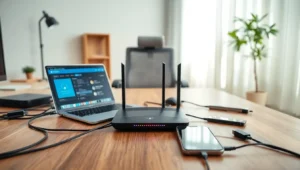In a world where traffic jams feel like a modern-day rite of passage, smart transportation systems are the superheroes we never knew we needed. Imagine zipping through city streets while your car and the traffic lights have a friendly chat, ensuring you get to your destination faster than you can say “are we there yet?” These systems aren’t just about getting from point A to point B; they’re about transforming the entire travel experience into something efficient and, dare we say, enjoyable.
As cities grow and infrastructure strains under the pressure, smart transportation is stepping up to the plate. With cutting-edge technology and innovative solutions, it’s tackling congestion, reducing emissions, and making commuting a breeze. So buckle up and get ready to explore how these tech-savvy systems are revolutionizing the way we travel, one pixel at a time.
Table of Contents
ToggleOverview of Smart Transportation Systems
Smart transportation systems integrate advanced technologies to create efficient and sustainable urban mobility solutions. These systems utilize real-time data to optimize traffic flow and enhance safety on the roads. Vehicles often communicate with infrastructure elements, like traffic lights, which reduces delays and improves commute times.
Data from the US Department of Transportation indicates that implementing smart transportation technologies can lead to a 20% reduction in congestion and related emissions. Cities have started employing tools like adaptive signal control systems, which adjust traffic light phases based on current traffic conditions. Such tools significantly enhance the flow of vehicles through high-traffic intersections.
Additionally, connected vehicles equipped with sensors provide drivers with critical information about road conditions and potential hazards. This not only enhances safety but also promotes an efficient driving experience. Public transportation systems benefit by analyzing passenger data to improve route planning and scheduling, ensuring that services align with user demand.
Furthermore, smart transportation systems emphasize user engagement through mobile applications, which offer real-time updates regarding transit schedules and traffic conditions. These applications facilitate informed decision-making, allowing users to choose the most efficient paths.
The combination of data analytics and communication technologies marks a significant transformation in urban transportation landscapes. Smart transportation systems aim to create not merely faster routes but also safer and more enjoyable travel experiences for all commuters.
Benefits of Smart Transportation Systems
Smart transportation systems offer numerous advantages that enhance urban mobility. They improve travel times, reduce congestion, and promote efficient use of resources.
Improved Efficiency
Smart transportation systems optimize traffic management by utilizing real-time data. Systems like adaptive signal control adjust traffic signals based on congestion levels, resulting in significant improvements. Research by the US Department of Transportation indicates these systems can achieve a 20% reduction in travel time. Furthermore, data analytics allow for better route planning. Efficiency gains lead to decreased fuel consumption, contributing to environmental sustainability. Increased connectivity between vehicles and infrastructure also helps facilitate smoother traffic flow. With better resource allocation, cities can accommodate growing populations.
Enhanced Safety
Safety remains a critical concern in urban transportation. Smart systems enhance safety by providing real-time information about road conditions. Connected vehicles equipped with sensors alert drivers to potential hazards, significantly reducing accident rates. The National Highway Traffic Safety Administration reports that these systems can cut crash rates by up to 40%. Integration of smart cameras and surveillance aids law enforcement in monitoring accidents more effectively. Predictive analytics can identify accident-prone locations, enabling proactive measures. Overall, improved safety features create more secure travel environments for all users.
Key Technologies in Smart Transportation Systems
Smart transportation systems rely on various technologies to innovate urban mobility. These technologies enhance efficiency and improve user experiences significantly.
IoT and Connectivity
IoT plays a crucial role in smart transportation. Devices communicate with each other and share real-time data, improving traffic management. Connected vehicles receive information from infrastructure elements, like traffic signals, which helps optimize driving routes. Enhanced connectivity leads to better coordination among different transportation modes, benefiting public transit users. For example, vehicles equipped with IoT sensors can inform drivers about road hazards and traffic conditions instantly, promoting safer journeys.
Data Analytics and AI
Data analytics and AI guide decision-making in smart transportation. Real-time data about traffic patterns enables systems to adjust signals accordingly, reducing congestion by 20%. AI algorithms analyze vast amounts of data to predict traffic conditions and demand trends. This information supports effective route planning and scheduling in public transportation systems. By leveraging past data, AI can make recommendations for optimizing transit services, enhancing the commuter experience, and increasing operational efficiency.
Challenges in Implementing Smart Transportation Systems
Smart transportation systems face several challenges during implementation. These obstacles can impact their effectiveness and adoption.
Infrastructure Limitations
Infrastructure limitations significantly hinder the deployment of smart transportation systems. Outdated road networks and insufficient public transport systems complicate the integration of advanced technologies. Many urban areas struggle with aging infrastructure, which often lacks the necessary upgrades for modern technology. Funding plays a crucial role; budgets may restrict improvements to the foundational elements of road safety and traffic management. Additionally, cities with limited space for expanding transportation avenues encounter constraints in accommodating connected vehicle technologies. Adapting existing infrastructure to support smart systems requires strategic planning and collaboration among stakeholders.
Privacy and Security Concerns
Privacy and security concerns pose significant barriers to smart transportation system adoption. Citizens worry about the collection of personal data through connected vehicles and smart devices. Data breaches can expose sensitive information, leading to distrust in these technologies. Regulatory frameworks must evolve to balance innovation with individual privacy rights. Potential vulnerabilities in system security can attract cyberattacks, risking safety and operation of transportation networks. Establishing robust cybersecurity measures becomes essential for ensuring user confidence and maintaining operational integrity. Addressing these concerns proactively promotes the development of secure and reliable smart transportation solutions.
Future Trends in Smart Transportation Systems
Emerging trends showcase the continued evolution of smart transportation systems. Autonomous vehicles promise to revolutionize how people navigate urban landscapes. These vehicles utilize advanced sensors and AI to operate safely alongside human drivers, enhancing overall road safety and efficiency.
Shared mobility platforms are gaining traction as a viable alternative to traditional car ownership. Ride-sharing and bike-sharing options provide users with on-demand transportation, reducing congestion and emissions in crowded urban areas. Public transport systems increasingly incorporate these options into their networks, expanding accessibility for commuters.
Integrating artificial intelligence into traffic management systems plays a significant role in future developments. AI algorithms can predict traffic patterns in real-time, facilitating optimal signal adjustments and minimizing delays on busy routes. Data-driven approaches make urban planning more responsive to real-time conditions, ultimately improving travel times.
Wireless communication technology will further enhance vehicle connectivity. V2X, or vehicle-to-everything communication, enables cars to share information with traffic lights, pedestrians, and other vehicles. This connectivity fosters safer interactions and a more cohesive traffic ecosystem.
Smart infrastructure will also lead to advancements in urban mobility. Smart traffic signals equipped with sensors detect real-time traffic volume, adjusting signal timing accordingly. Investments in this infrastructure can significantly reduce congestion by as much as 20%, as documented by the US Department of Transportation.
User-centric mobile applications continue to evolve, providing personalized travel updates. Commuters benefit from real-time information about public transit schedules and traffic conditions, promoting informed decision-making. Future applications will likely offer enhanced features such as predictive analytics for personalized route recommendations.
Sustainability will underpin future developments in smart transportation systems as cities face mounting pressure to reduce carbon footprints. Eco-friendly vehicle technologies, including electric and hydrogen-powered options, will play a crucial role in transforming urban mobility. Innovative solutions like these contribute to a more sustainable and efficient transportation landscape.
Smart transportation systems are reshaping urban mobility by leveraging technology to create efficient and sustainable travel experiences. These innovations not only streamline traffic flow but also enhance safety and reduce environmental impact. As cities continue to grow and evolve, the integration of smart systems will be crucial in addressing modern transportation challenges.
The future promises even more advancements with autonomous vehicles and improved connectivity. By focusing on user engagement and sustainability, smart transportation systems will play a vital role in creating safer and more enjoyable journeys for everyone. Embracing these technologies is essential for building a resilient and efficient transportation landscape.





